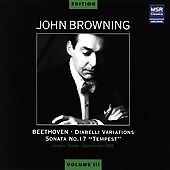Volume 3 of MSR’s John Browning edition is all Beethoven, featuring a live Austin, Texas performance of the Diabelli Variations from September, 1965. Although the archival recording’s muffled quality suggests a tape several generations removed from the source, the sound remains pleasant and well balanced. Indeed, I prefer it to the relatively strident pickup characterizing Browning’s out-of-print studio recording of similar vintage issued by RCA Victor (never on CD). Rehearing the latter after more than 30 years, I found Browning’s impeccably turned out, headstrong pianism operating more or less on the same emotional and dramatic level throughout. In contrast, the presence of an audience elicits more colorful and dynamically charged results all around.
Still, Browning’s quest for pianistic symmetry and unruffled poise frequently shortchanges the music’s angular, uncouth qualities and dramatic surprises. For instance, he tends to round off lyrical variations like Nos. 3, 8, and 11 to the point where you can predict the ritards and caesuras. There are other telltale examples: In No. 17, Browning keeps the finger-twisting right-hand figurations on an even keel, downplaying their important melodic outlines, and he tosses off No. 19 in toccata-like fashion, gliding over the cross-rhythmic effects Beethoven intended. To be fair, the performance gains momentum, continuity, and simplicity from Variation 19 onward. I especially was moved by Browning’s selfless concentration and prismatic clarity in the Fughetta Variation 24.
In Browning’s hands, you might be tempted to dub Beethoven’s Op. 31 No. 2 the “Tempestuous” sonata. He shakes the outer movements by their scruffs and projects the rotary left-hand accompanying figurations with uncommon cleanliness and point, while also observing the composer’s controversial long pedal marks. It’s a pity that he ignores the repeats. Some listeners may prefer a darker, more disembodied patina in the slow movement, yet if anything, Browning’s lean-limbed reserve and decidedly unhazy textures fortify the music’s eloquence without becoming militant. Although no date can be ascertained for this performance, it certainly does not sound dated! In all, this is a flawed but fascinating glimpse of a pianist’s pianist who recorded less than he should have.
































